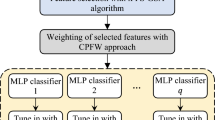Abstract
Breast cancer is a common to females worldwide. Today, technological advancements in cancer treatment innovations have increased the survival rates. Many theoretical and experimental studies have shown that a multiple classifier system is an effective technique for reducing prediction errors. This study compared the particle swarm optimizer (PSO) based artificial neural network (ANN), the adaptive neuro-fuzzy inference system (ANFIS), and a case-based reasoning (CBR) classifier with a logistic regression model and decision tree model. It also applied three classification techniques to the Mammographic Mass Data Set, and measured its improvements in accuracy and classification errors. The experimental results showed that, the best CBR-based classification accuracy is 83.60%, and the classification accuracies of the PSO-based ANN classifier and ANFIS are 91.10% and 92.80%, respectively.




Similar content being viewed by others
References
Mangasarian, O. L., Street, W. N., and Wolberg, W. H., Breast cancer diagnosis and prognosis via linear programming. Oper. Res. 43(4):570–577, 1995.
Xiong, X., Kim, Y., Baek, Y., Rhee, D. W., and Kim, S. H., Analysis of breast cancer using data mining & statistical techniques, Sixth International Conference on Software Engineering, Artificial Intelligence, Networking and Parallel/Distributed Computing, 2005 and First ACIS International Workshop on Self-Assembling Wireless Networks. SNPD/SAWN, pp. 82–87, (2005).
Nilsson, M., and Sollenborn, M., Advancements and trends in medical case-based reasoning: An overview of systems and system development, International Florida Artificial Intelligence Research Society Conference (FLAIRS 2004), Miami Beach, FL(US), 1 pp. 17–19, (2004).
Lieber, J., and Bresson, B., Case-based reasoning for breast cancer treatment decision helping. Proceedings of the 5th European Workshop on Case-Based Reasoning, pp. 173–185, (2000).
Pandey, B., and Mishra, R. B., Knowledge and intelligent computing system in medicine. Comput. Biol. Med. 39(3):215–230, 2009.
Demuth, H., and Beale, M., Neural network toolbox user’s guide for use with MATLAB. MathWorks Inc., Natick, MA, 2006.
Sexton, R. S., Dorsey, R. E., and Sikander, N. A., Simultaneous optimization of neural network function and architecture algorithm. Decis. Support Syst. 36(3):283–296, 2004.
Pandey, B., and Mishra, R. B., Knowledge and intelligent computing system in medicine. Comput. Biol. Med. 39:215–230, 2009.
Jang, J.-S. R., ANFIS: Adaptive-network- based fuzzy inference system. IEEE Trans. Syst. Man Cybern. 23(3):665–685, 1995.
Riedl, C. C., Pfarl, G., and Helbich, T. H., Breast imaging reporting and data system, http://www.birads.at/.
Elter, M., Schulz-Wendtland, R., and Wittenberg, T., Mammographic Mass Data Set, http://archive.ics.uci.edu/ml/datasets/Mammographic+Mass, 2007.
Mammogram Interpretation: Categories and the ACR/BI-RADS, http://www.imaginis.com/breasthealth/acrbi.asp, (2007).
Schank, R. C., and Abelson, R. P., Scripts, plans, goals, and understanding: An inquiry into human knowledge structures. Erlbaum, Hillsdale, New Jersey, 1977.
Burke, E. K., MacCarthy, B., Petrovic, S., and Qu, R., Structured cases in case-based reasoning-re-using and adapting cases for time-tabling problems. Knowl.-Based Syst. 13(2–3):159–165, 2000.
Althoff, K. D., Auriol, E., Barletta, R., and Manago, M., A Review of Industrial case-based reasoning tools, An AI perspectives Report. AI Intelligence, United Kingdom, pp. 3–4, 1995.
Zhang, Z., and Yang, Q., Feature weight maintenance in case bases using introspective learning. J. Intell. Inf. Syst. 16(2):95–116, 2001.
Quinlan, J. R., C4.5: Programs for machine learning. Morgan Kaufmann Publishers, (1993).
Mitra, S., and Hayashi, Y., Neuro-fuzzy rule generation: Survey in soft computing framework. IEEE Trans. Neural Netw. 11(3):748–768, 2000.
Xing, E. P., Jordan, M. I., and Karp, R. M., Feature selection for high-dimensional genomic microarray data, in: Proc. of the 18th International Conference on Machine Learning, pp. 601–608, (2001).
Hosmer, D. W., and Lemeshow, S., Applied logistic regression, 2nd edition. Wiley, New York, 2000.
Yu, J., Wang, S., and Xi, L., Evolving artificial neural networks using an improved PSO and DPSO. Neurocomputing 71(4–6):1054–1060, 2008.
Kennedy, J., and Eberhart, R. C., Particle swarm optimization. In: IEEE International Conference on Neural Networks. IEEE, New York, pp. 1942–1948, 1995.
Geethanjali, M., Slochanal, S. M. R., and Bhavani, R., PSO trained ANN-based differential protection scheme. Neurocomputing 71(1–3):904–918, 2008.
Parsopoulos, K. E., and Vrahatis, M. N., Recent approaches to global optimization problems through Particle Swarm Optimization. Nat. Comput. 1(2–3):235–306, 2002.
Hu, K., and Huang, S. H., Solving inverse problems using Particle Swarm Optimization: An application to aircraft fuel measurement considering sensor failure. Intell. Data Anal. 20(1):421–434, 2007.
Sadeghi, B. H. M., A BP-neural network predictor model for plastic injection molding process. J. Mater. Process. Technol. 103(3):411–416, 2000.
Jang, J.-S. R., Sun, C. T., and Mizutani, E., Neuro-Fuzzy and soft computing: A computational approach to learning and machine intelligence, Prentice Hall; US Ed edition Prentice-Hall, (1996).
Papadimitriou, S., and Terzidis, K., Efficient and interpretable fuzzy classifiers from data with support vector learning. Intell. Data Anal. 9(6):527–550, 2005.
Mohammad, R., Akbarzadeh, T., and Majid, M. K., A hierarchical fuzzy rule-based approach to aphasia diagnosis. J. Biomed. Inform. 40(5):465–475, 2007.
Castellano, G., Fanelli, A. M., and Mencar, C., An empirical risk functional to improve learning in a neuro-fuzzy classifier. IEEE Trans. Syst. Man Cybern. Part B-Cybern. 34(1):725–731, 2004.
Ghazavi, S. N., and Liao, T. W., Medical data mining by fuzzy modeling with selected features. Artif. Intell. Med. 43(3):195–206, 2008.
Swets, J. A., Measuring the accuracy of diagnostic systems. Science 240(4857):1285–1293, 1988.
Bradley, A. P., The use of the area under the ROC curve in the evaluation of machine learning algorithms. Pattern Recognit. 30(7):1145–1159, 1997.
Author information
Authors and Affiliations
Corresponding author
Rights and permissions
About this article
Cite this article
Huang, ML., Hung, YH., Lee, WM. et al. Usage of Case-Based Reasoning, Neural Network and Adaptive Neuro-Fuzzy Inference System Classification Techniques in Breast Cancer Dataset Classification Diagnosis. J Med Syst 36, 407–414 (2012). https://doi.org/10.1007/s10916-010-9485-0
Received:
Accepted:
Published:
Issue Date:
DOI: https://doi.org/10.1007/s10916-010-9485-0




